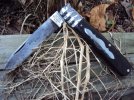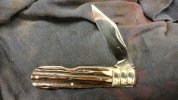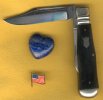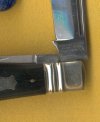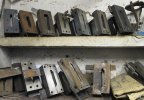I've only ever seen it with single blades before. The system in Sheffield certainly takes some understanding!


I was trying to explain it to another friend recently, though this was in relation to the consistency of Sheffield tang stamps, in terms of dating knives:
Unless you've witnessed the vagaries of the Little Mester system in Sheffield. (and of course I've only witnessed the 'fag-end' of it), I think it's extremely hard to imagine how it worked, with thousands of independent cutlers, and tiny firms, working out of homes and workshops all over the city, with blackened windows, and no street sign. Even in my day, it was sometimes only possible to track these small makers down by word of mouth, and using your nose to sniff out the smell of industry. The larger firms rotated their outworkers regularly to keep costs down, so the cutlers were competing with each other for the lowest price (in the dying days of the industry, there was a lot of bickering among the Little Mesters, and them under-cutting each other, to try and get work). As larger firms contracted work to Little Mesters, if the job was too big, or they were busy, they might in turn sub-contact part of the job, or even all of it, to others.
Tang stamps wear faster than many people would imagine, and while the most prestigious firms would have replaced them regularly, even they might have struggled to supply up to date stamps to everyone involved in the labyrinthine chain of production. Depending on their position in that chain, the cutlers may have received ready-stamped blades, or been issued with a stamp, with these often being held onto for future use (most Little Mesters I've known had a good collection of stamps - one still has my 'Jack Black Knives' stamp!). From what I know of Sheffield cutlers, the smaller firms and Little Mesters, would have used their stamps well past the point where they cut crisply, and certainly wouldn't have changed them because there was a new monarch on the throne, for example (we see this even with Rodgers knives).
How was the work given out? In some cases, the Little Mesters came to the big firms to ask for work, taking away a parcel of parts under the 'liver and draw' system (getting paid when the finished knives were delivered). In other cases, an apprentice or clerk might be sent out with a note from the gaffer, and maybe even a catalogue clipping (if the firm had a catalogue) or sample. In later times, there might be a telephone conversation, though not many Little Mesters had telephones in their workshops, even in recent times, and some not at home. Let us imagine though, that Mr Arkwright rings Mr Smith, and asks him if he can make him up 4 gross of Lambsfoot knives, 4 gross of Peach Pruners, and 4 gross of Sleeveboard Penknives, all 'Town Patterns', patterns Mr Smith, the cutler, is very familiar with, and knows how Mr Arkwright's company interprets them. There will be some haggling over price, which Mr Arkwright will probably cut subsequently. Among his collection of blanking out tools, Mr Smith has all the tools he needs for the job (see photo below of tools from A.Wright/J.Howarth, who did a lot of contract work for other firms, many are over a hundred years old), and he also has a stamp relating to Mr Arkwright's firm. However, that stamp may be 10 years old, maybe more, and a little different to the stamp Mr Roberts, the cutler 3 doors down, who also does work for Mr Arkwright's firm, is using.
[I have papers showing how Joseph Rodgers sub-contracted work to Jack Howarth, supplying catalogue papers with the required patterns marked, and amended with comments regarding covers, etc, as well as a formal list of the number of knives required.]
View attachment 1584391
Often there would be leftover blades, sometimes a lot of them, if an order was cancelled, a firm went bust (which often happened overnight), or a cutler passed away. These would rarely be thrown away, though it sometimes happened (when Rodgers' cutlers moved to the Richards factory after the Imperial takeover, they threw all their parts in the River Sheaf), and would be made into knives at some point, either with the original stamp, or without it. For example, I bought a bunch of Saynor knives about 10 years ago, which had old Saynor blades, but had been made up relatively recently, and I remember a cutler I knew finding a box of Truelove Bowie blades in his workshop - in the early 1990's! Stan Shaw had a whole collection of old forged blades, which he re-used.
It's worth noting that sometimes firms loaned the blanking out and machine-grinding tools to Little Mesters they had sub-contracted to, but they weren't always returned. In the late 1980's and early 1990's, the main work undertaken by a small Sheffield (father and son) firm was producing Sgian Dubh blades (stamped 'hand-made', but actually machine-ground), which went to Scotland to be hafted and finished there. The tools they used had been loaned to them when they did a job for Eggington, but they flatly refused to return them. Ron Brookes, the old gaffer at Eggington spent more than a decade trying to get them back, without success -I saw him a few years back, and he's still fuming about it!
Jack Black !!



